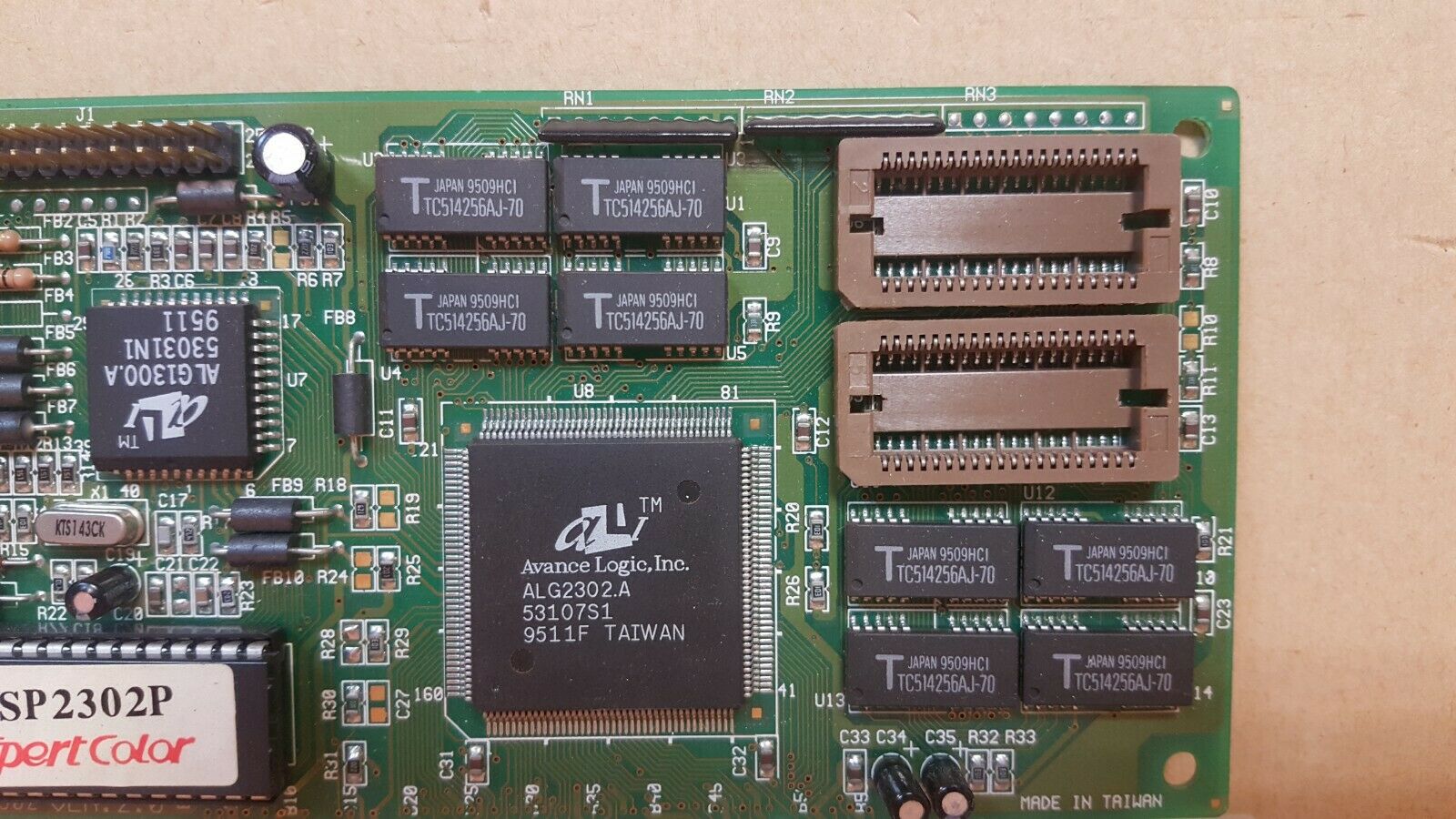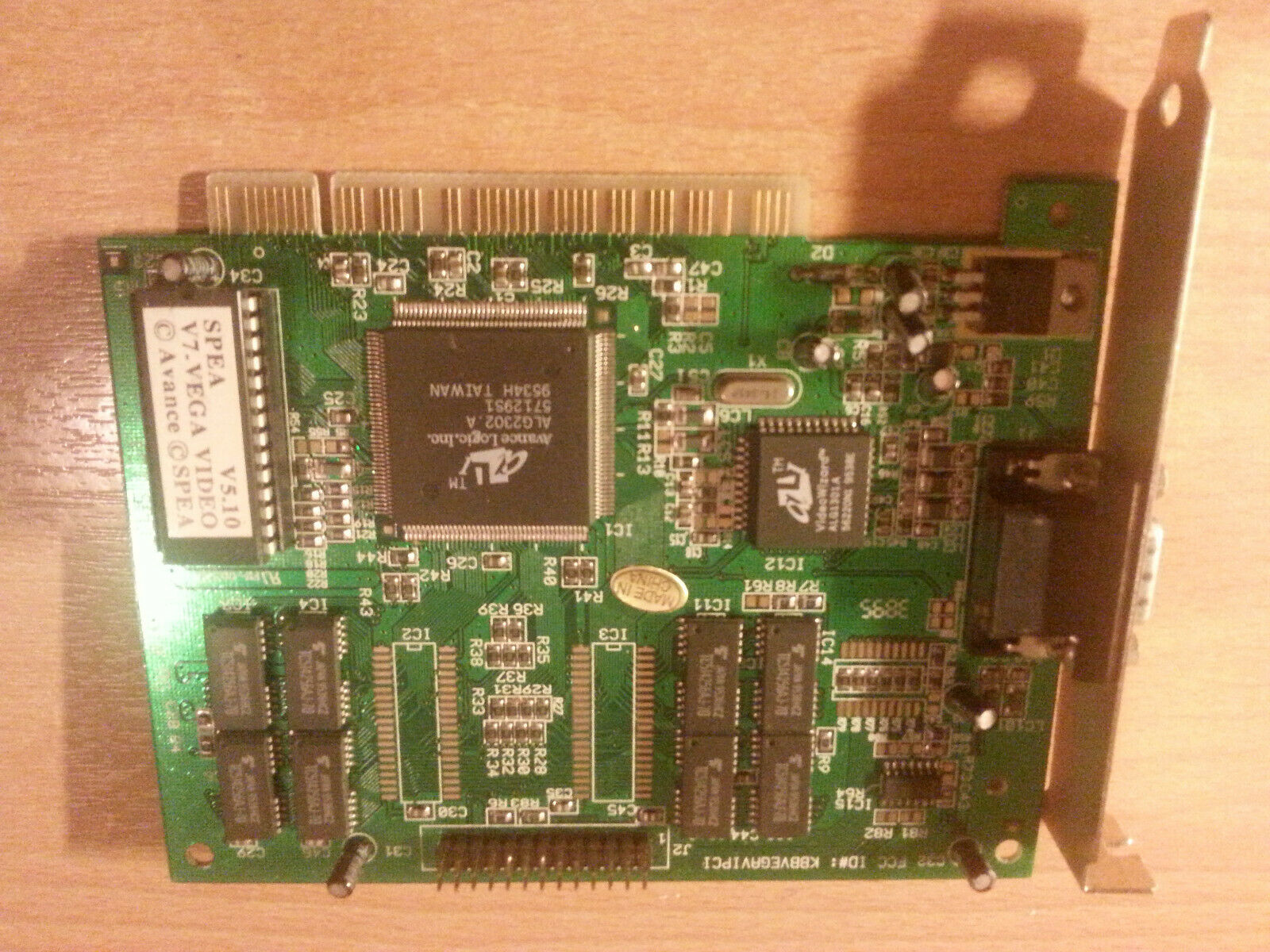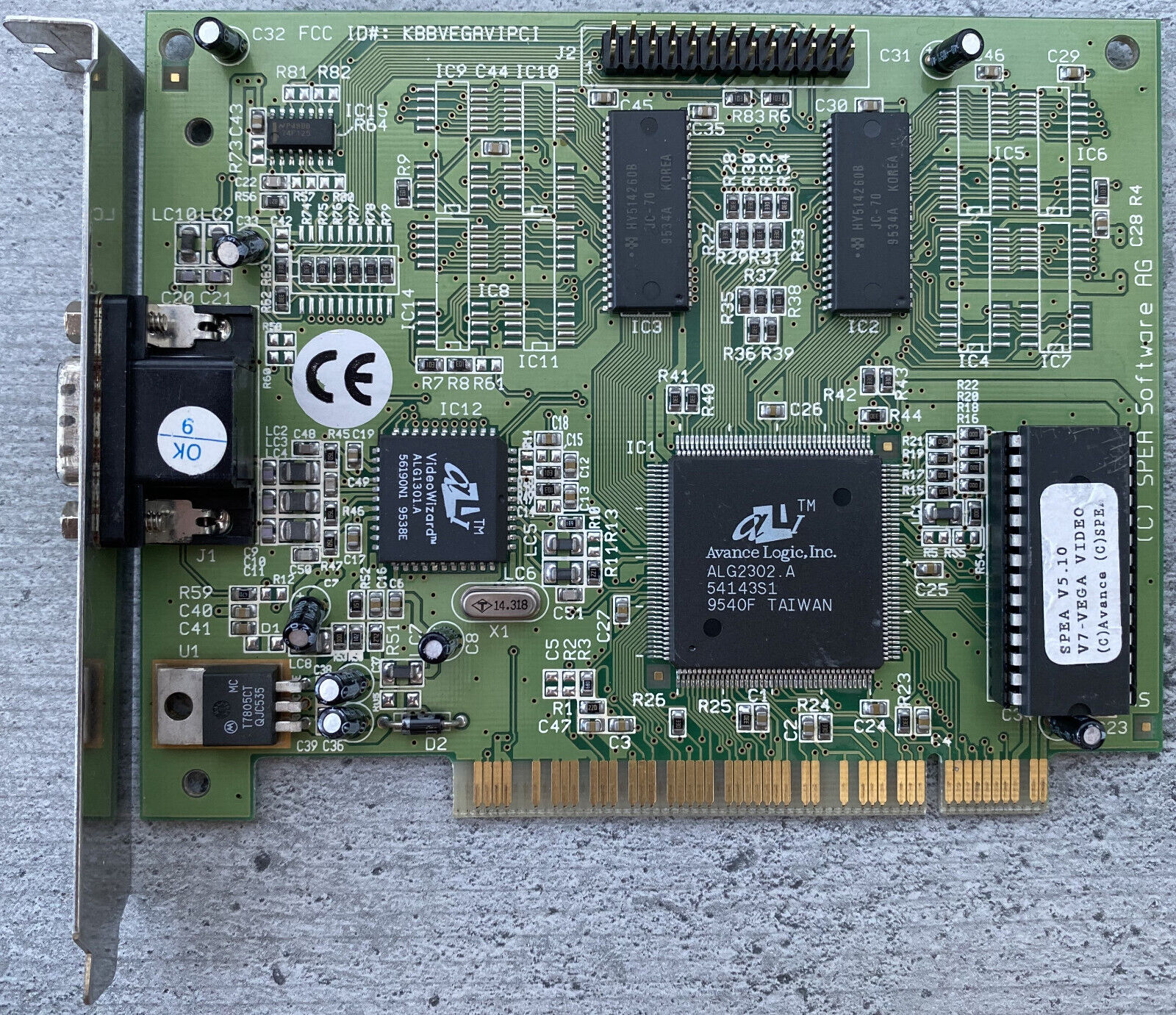Avance Logic was a budget sound and graphics card manufacturer who got acquired by Realtek, of Taiwan.
They also sold their board designs to third parties who rebranded them.
 ALS007 / ALS007SP ALS007 / ALS007SP      
Introduced: 1996
FM Synthesizer: LS262 (OPL3 clone)
Bus: 16-bit ISA
CD-ROM Interfaces: IDE
Jacks: Line In, Line Out, Mic, Speaker
Wavetable Header: Yes
Plug & Play: Yes
FCC ID: JQDS007AS9543C, MZY3D007S3 or MA5ASOUND
The ALS007 is a Sound Blaster, Pro and Sound Blaster 16-compatible card. For OPL3 music it has an LS262 chip. The game/MIDI port can be used as an MPU-401 interface (UART only), and the card also gets an IDE interface for a CD-ROM which is initialised using a file called CDSETUP.SYS.
ALS007 is a Plug & Play card, so has no jumpers for I/O port, IRQ, or DMA settings. Instead, the installation disk provides a utility, ALCONFIG.EXE to configure the card's settings. The wavetable header is Creative Wave Blaster-compatible.
This ALS007 card was also sold as the Asonic Asound-007/XX, released in 1996, as well as the SoundTrek.
I have seen ALS007 cards with the same FCC ID as the ALS100 and ALS100Plus+ (MA5ASOUND), which is odd.
The ALS007SP is very similar to the ALS007 but is not a Plug & Play card. In all other respects they are the same. A file called ALSINIT.EXE is used to initialise the ALS007SP's sound chip.
According to the installation disk readme file, if you have issues installing under Windows, you should try installing the drivers for each device manually. For reference they are:
Logic Device 0 = Wav Audio Device;
Logic Device 1 = Internal Midi (OPL-3) Device;
Logic Device 2 = Joy Stick/Game Port Device;
Logic Device 3 =
External Midi (MPU-401) Device;
Logic Device 4 = IDE CD ROM
Controller.
Drivers
DOS / Windows 3.1 / 95 (722 KB Windows self-extracting zip file)
DOS / Windows 3.1 / 95 vA1.60 (757 KB Windows self-extracting zip file)
DOS Production Board Test Program v1.0
Windows 98 (910 KB Windows self-extracting zip file)
NT 3.51 / 4.0 (104 KB Windows self-extracting zip file)
OS/2 4.0 (131 KB Windows self-extracting zip file)
More Images
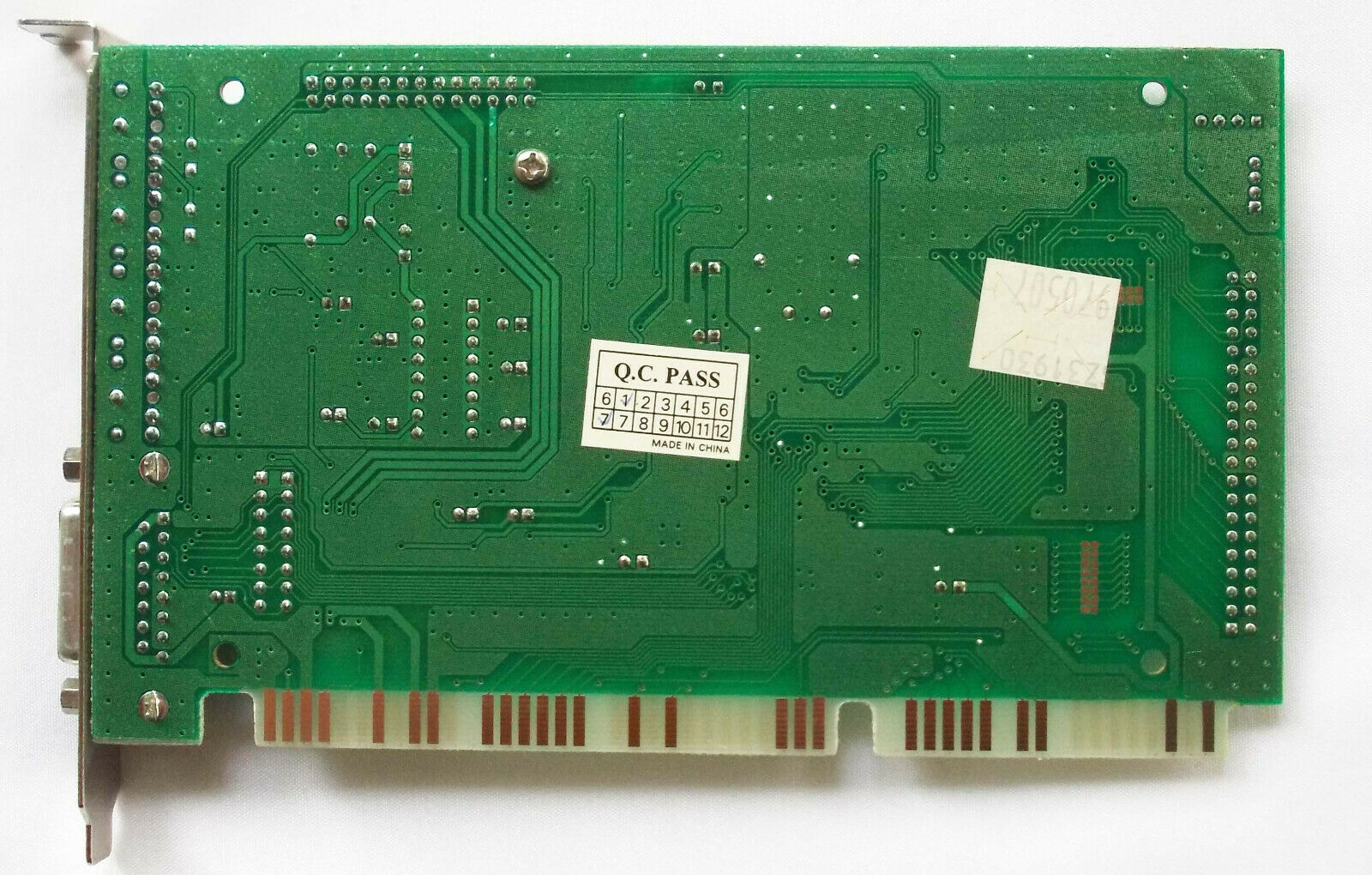 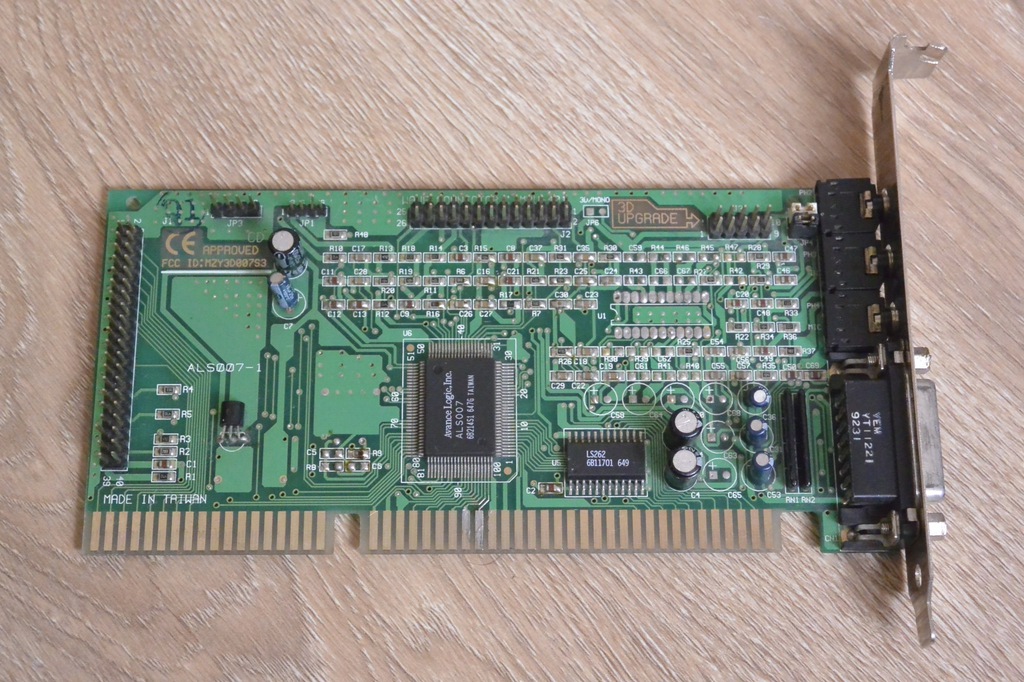 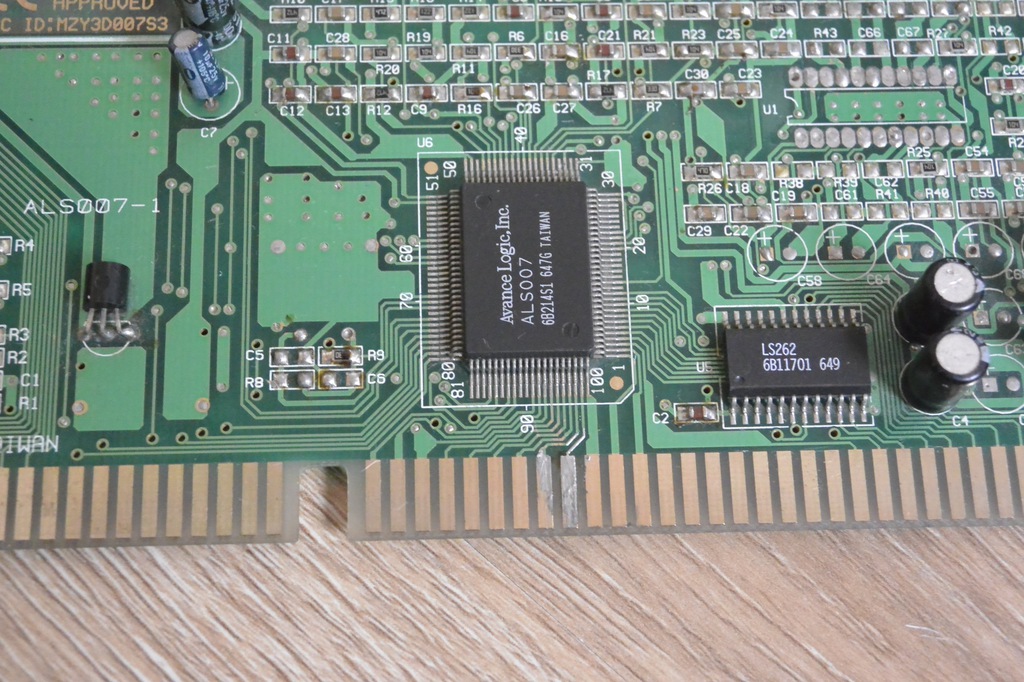 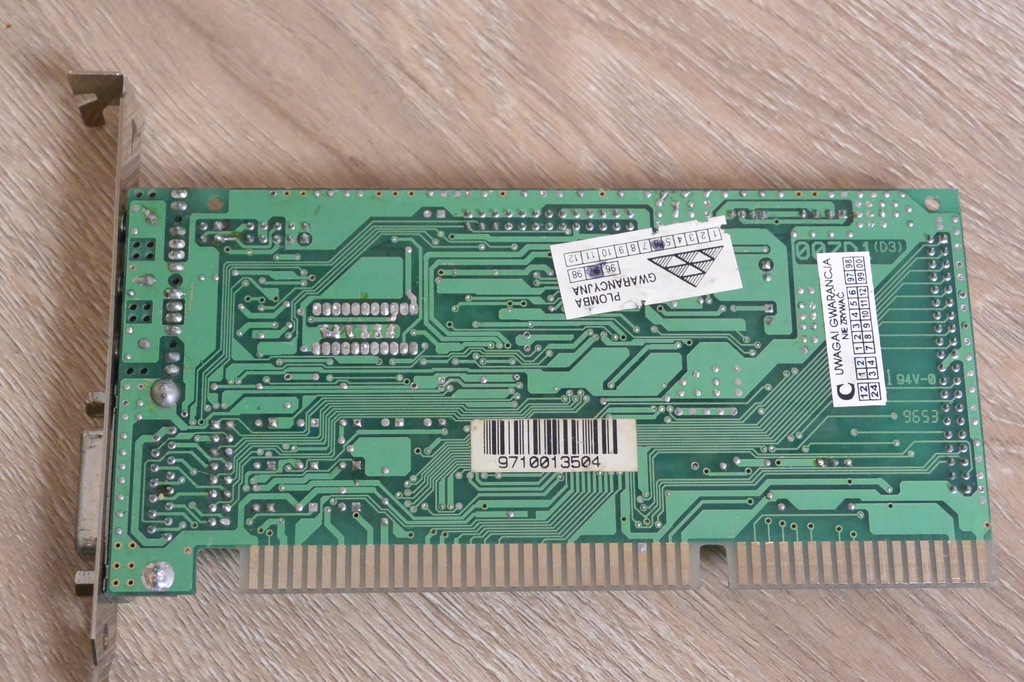   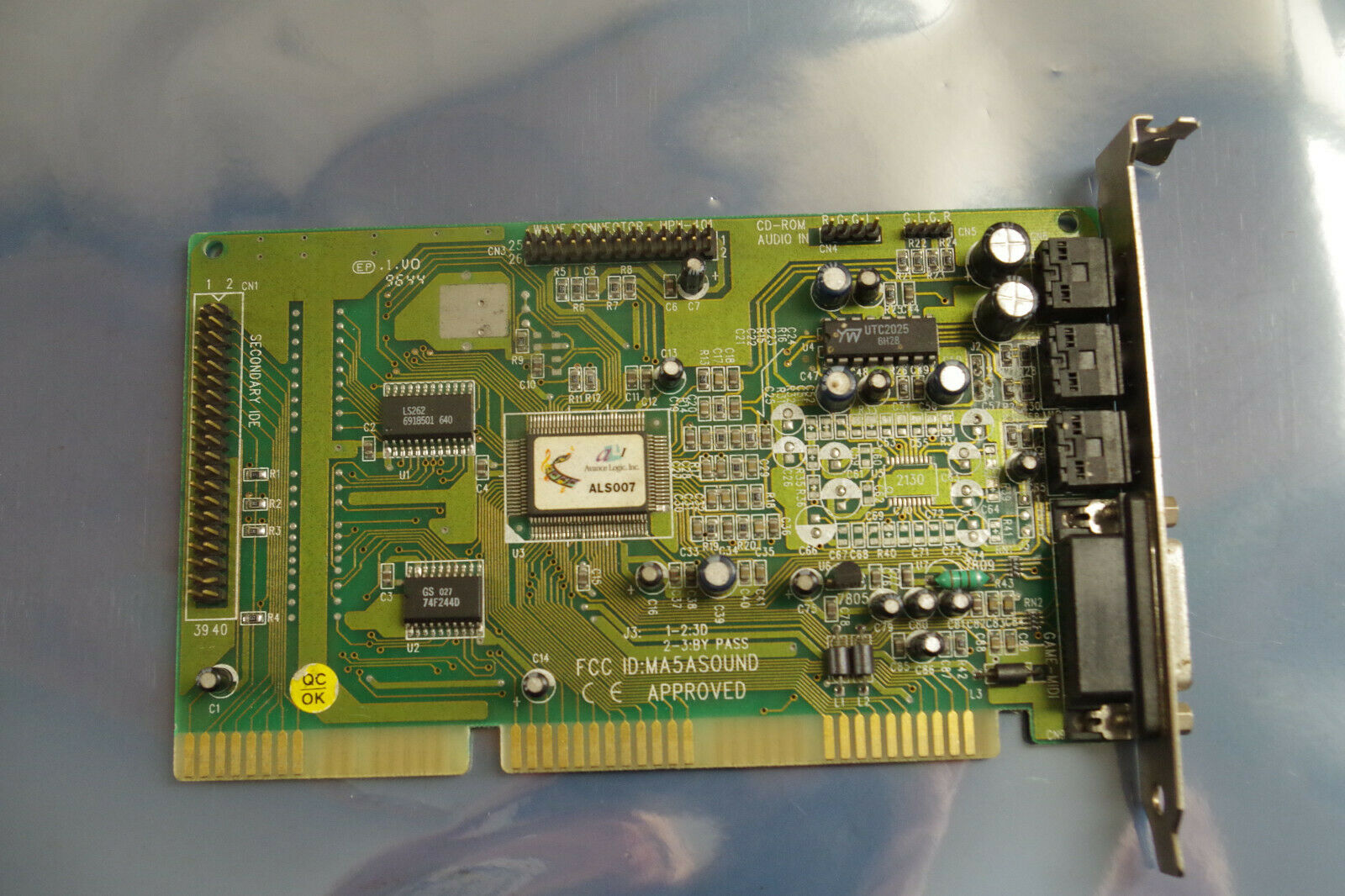 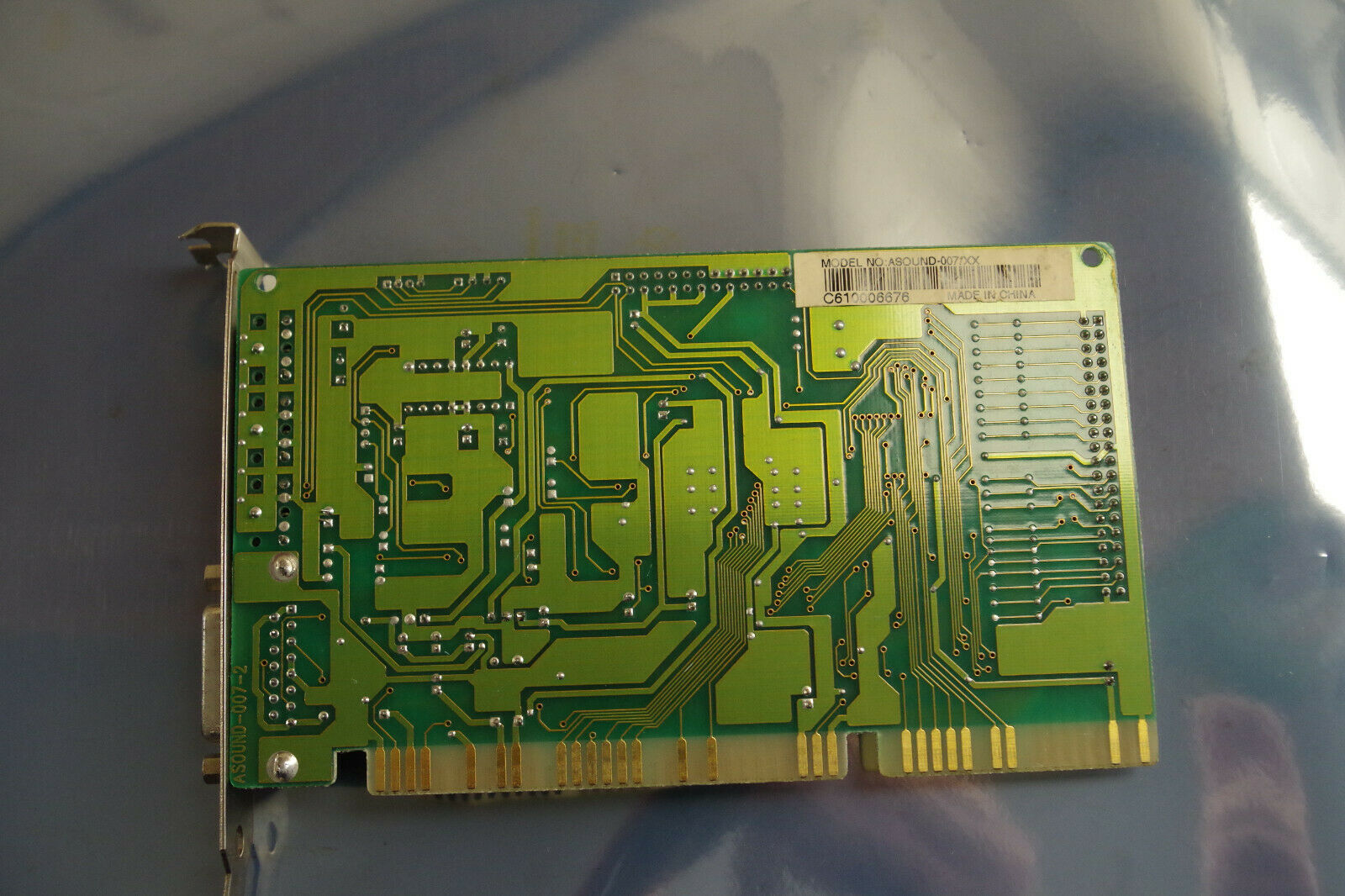
|
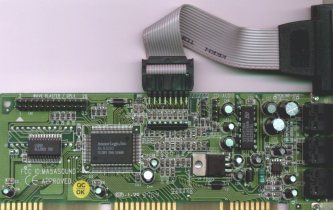 ALS100 / ALS110 ALS100 / ALS110     
Introduced: 1997
FM Synthesizer: LS262 (OPL3 clone)
Bus: 16-bit ISA
CD-ROM Interfaces: IDE
Jacks: Line Out, Mic, Speaker
Wavetable Header: Yes
Plug & Play: No
FCC ID: MGYPRO16PNP, MA5ASOUND
The ALS100 from Avance Logic was a budget 16-bit sound card, and was the last ALS card to contain a dedicated Yamaha OPL3 clone - the LS262. After this, Avance Logic moved to a more tightly integrated chip (the ALS100+) that used what they called "ALSFM" - an embedded FM synth that was OPL3-compatible (though not a direct clone) and DAC.
ALS100 is *not* a Plug & Play card but there are no jumpers for I/O port, IRQ, or DMA settings. Instead, the card's configuration is stored on the ALS100 chip and is configured via the AWCONFIG.EXE utility (very similar to the earlier ALCONFIG.EXE). Run this after you have run DOSINST.EXE to install the software to your hard disk.
The game/MIDI port can be used as an MPU-401 interface (UART only) which is hanging note bug-free, and the card also gets an IDE interface for a CD-ROM which is initialised using a file called CDSETUP.SYS.
Like the ALS007, what makes this card stand out against its competitors is its support for Sound Blaster 16 in addition to Sound Blaster and Sound Blaster Pro.
The ALS100 was also sold as the Asonic Asound Plus 4, released in 1997. It had an FCC ID of MA5ASOUND. It was also sold as the Wave Melody, with the main chip rebadged as the "3D Melody MF1000".
It is sadly known to be quite a noisy card (audio quality-wise), and does require a TSR driver.
As for main ASIC itself, the ALS100L chip is a low-power version of the ALS100, but is otherwise identical. ALS100M chips have additional support for multiple CD-ROM interfaces from Mitsumi, Sony and Panasonic.
Manuals
ALS100/ALS100L/ALS100M User Manual
ALS100/ALS100L/ALS100M Design Manual
Drivers
DOS / Windows 3.1 / 95
DOS Production Board Test Program v1.0
Windows 98
NT 3.51 / 4.0
OS/2 4.0
More Images

|
ALS100Plus / ALS100Plus PnP       
Introduced: 1997
FM Synthesizer: Embedded in ALS100Plus+ chip
Bus: 16-bit ISA
CD-ROM Interfaces: IDE
Jacks: Line Out, Mic, Speaker
Wavetable Header: Yes
Plug & Play: Yes
FCC ID: MAA8S280005 or MA5ASOUND
Known Board Revisions: 2.1
The ALS100Plus is a Sound Blaster Pro 2.0 (stereo) and Sound Blaster 16-compatible card.
ALS100Plus is a Plug & Play card, so has no jumpers for I/O port, IRQ, or DMA settings. The game/MIDI port can be used as an MPU-401 interface (UART only) which is hanging note bug-free, and the card also gets an IDE interface for a CD-ROM which is initialised using a file called CDSETUP.SYS.
These cards have very poor OPL3 emulation - the FM synthesizer was embedded into the AL100Plus+ chip, rather than being a dedicated external chip as on the earlier AL007 and AL100 sound cards. This was not a clone of an OPL3, but rather Avance Logic's own FM synthesizer that was compatible with OPL3, which they called "ALSFM".
It's possible the ALS100 Plus also lacks the 16-bit DMA ability the ALS100 had. You can only set the low and high DMA channels to 1 or 3, preventing 16-bit sound in BUILD engine games.
These things make the ALS100Plus a worse card than the earlier ALS100 so don't be fooled by the "Plus" moniker.
This card was also sold as the Asonic Asound Gold, released in 1997. It had an FCC ID of MA5ASOUND.
Manuals
ALS100Plus+ User Guide
Drivers
DOS / Windows 3.1 / 95
Windows 98
NT 3.51 / 4.0
Windows 2000
OS/2 4.0
More Images
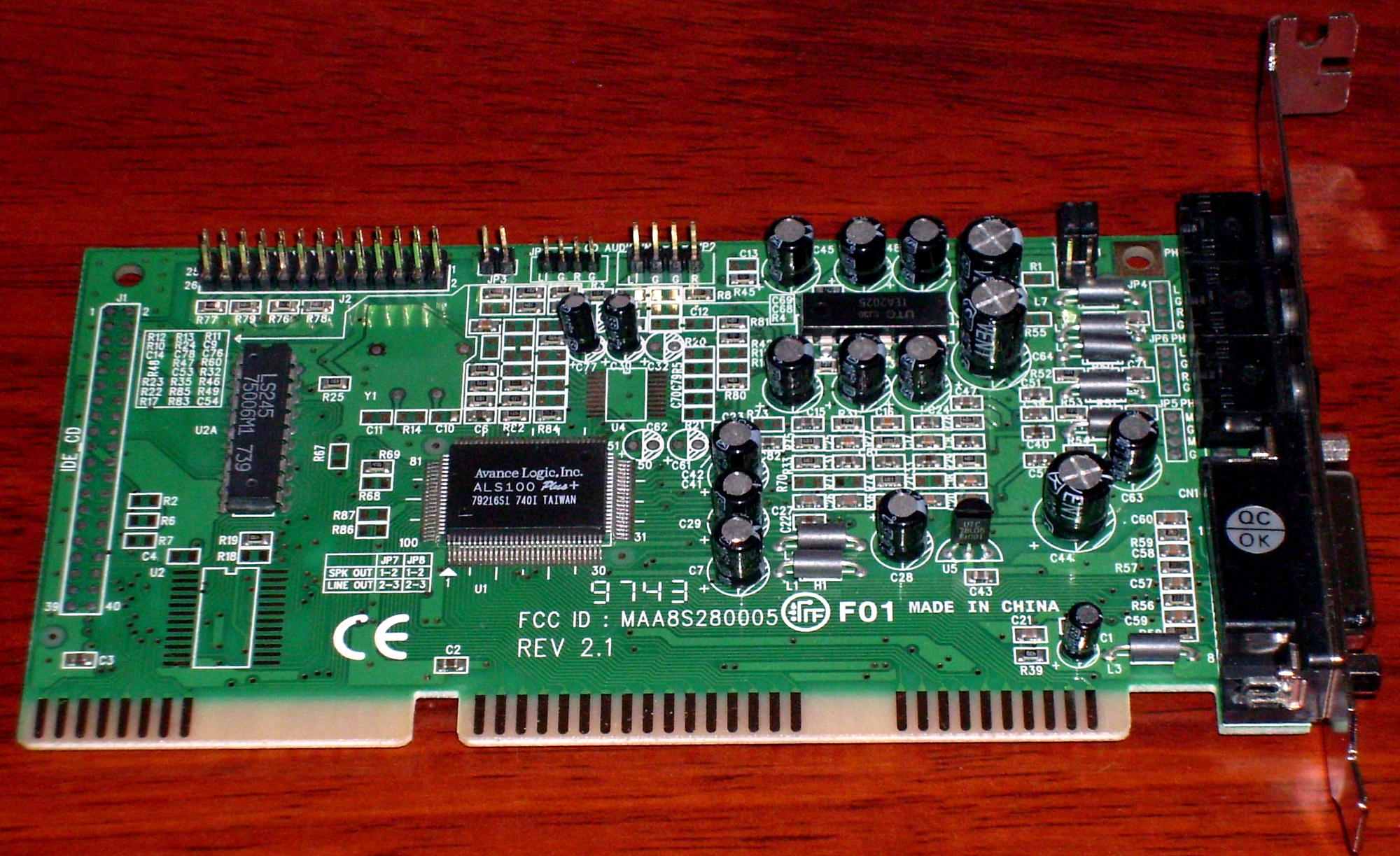  .jpg) 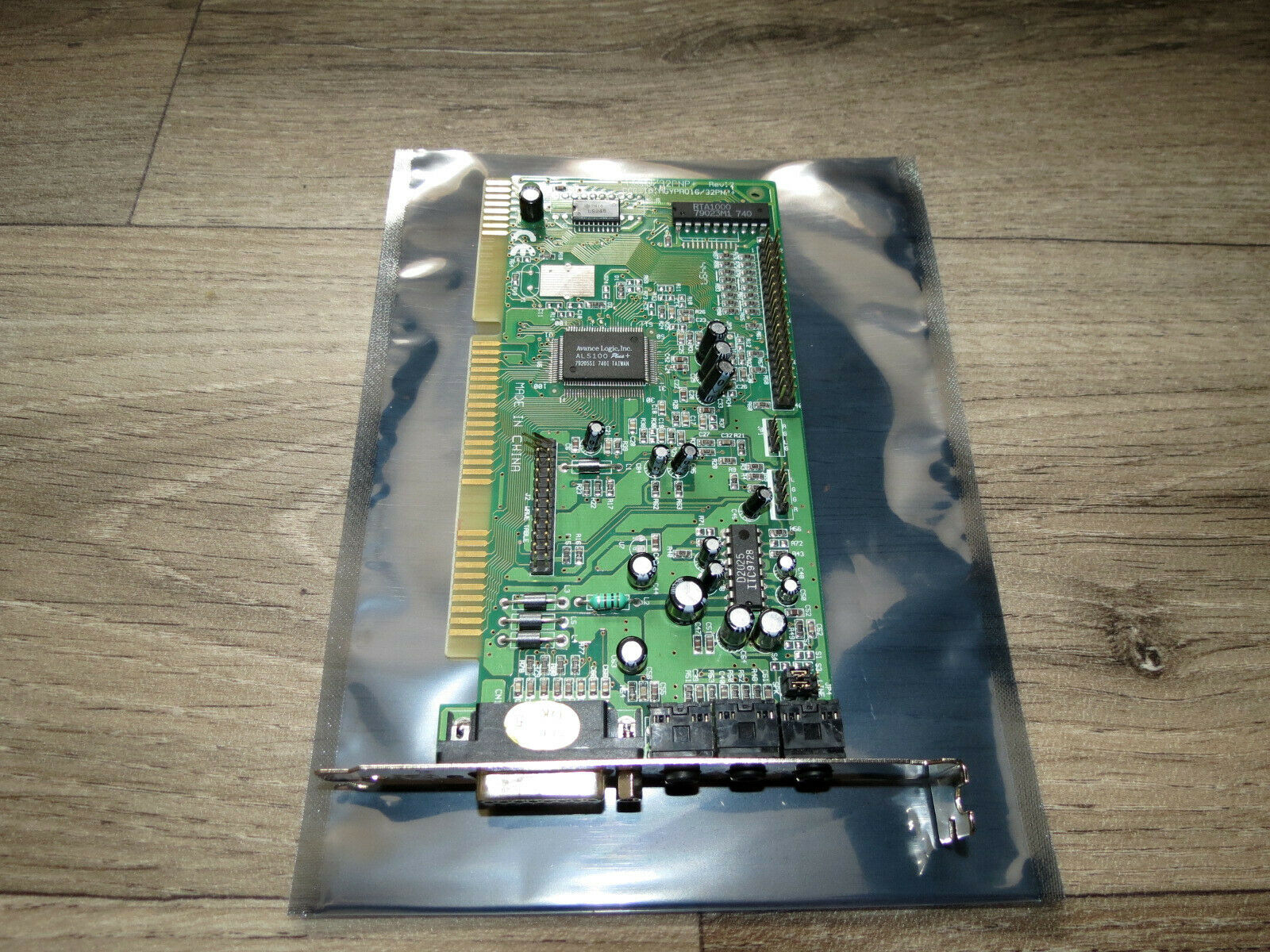 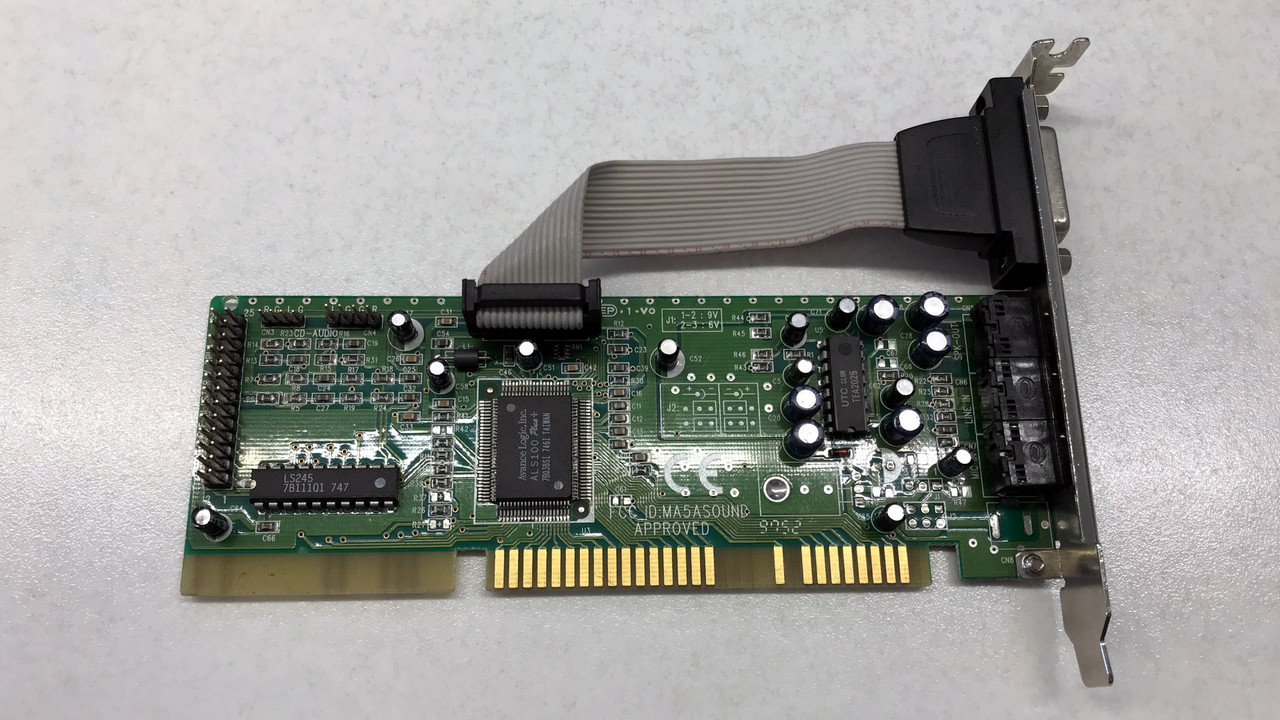
|
ALS100Plus Pro16/32 PnP+      
Introduced: 1997
FM Synthesizer: Embedded in ALS100Plus+ chip
Bus: 16-bit ISA
CD-ROM Interfaces: IDE
Jacks: Line Out, Mic, Speaker
Wavetable Header: Yes
Plug & Play: Yes
FCC ID: MGYPRO16/32PNP+.
Known Board Revisions: 1A (see image right), 2 (1st below), 4 (2nd onwards below)
Manuals
ALS100Plus+ User Guide
Drivers
DOS / Windows 3.1 / 95
Windows 98
NT 3.51 / 4.0
Windows 2000
OS/2 4.0
More Images
  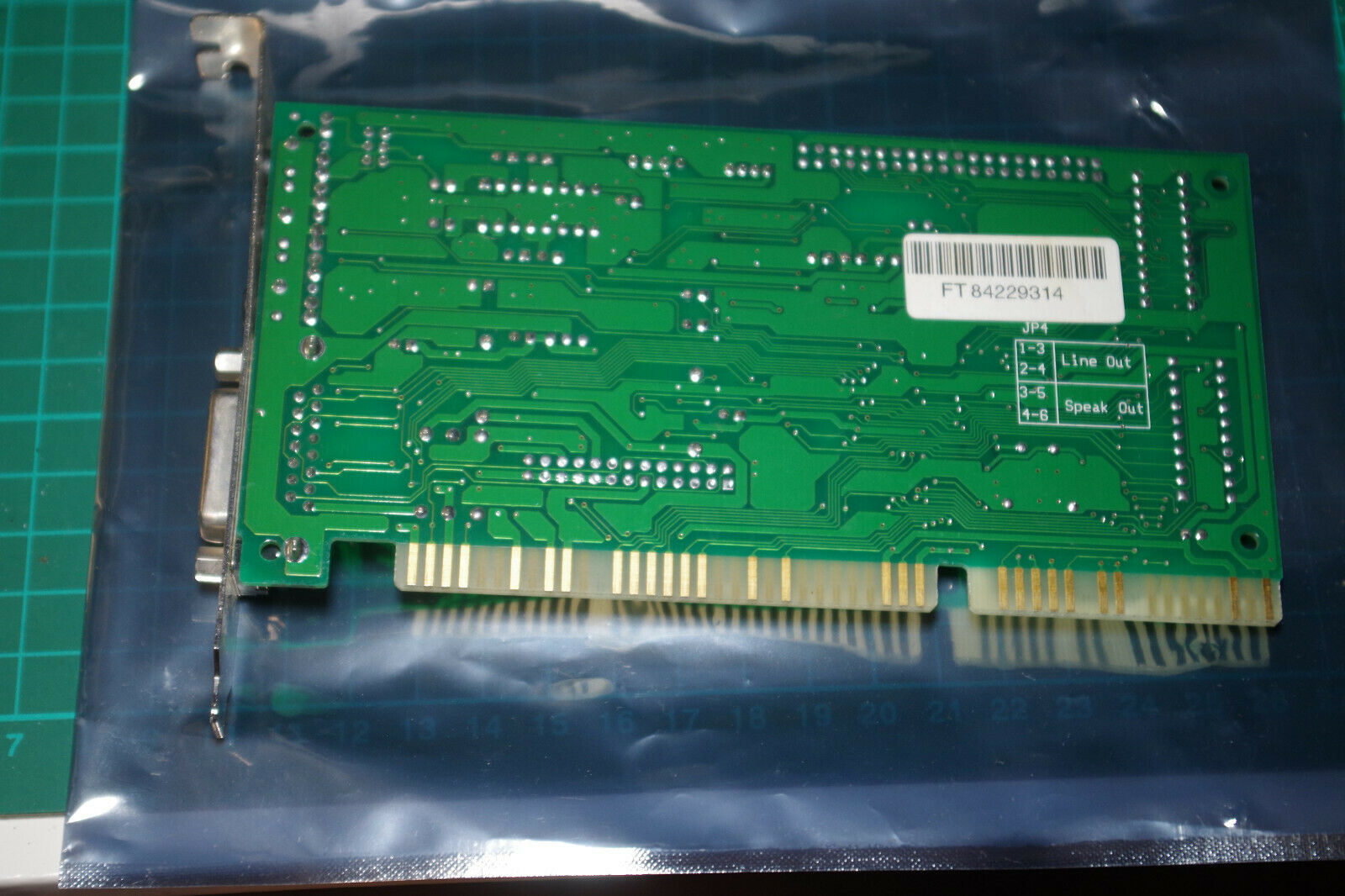 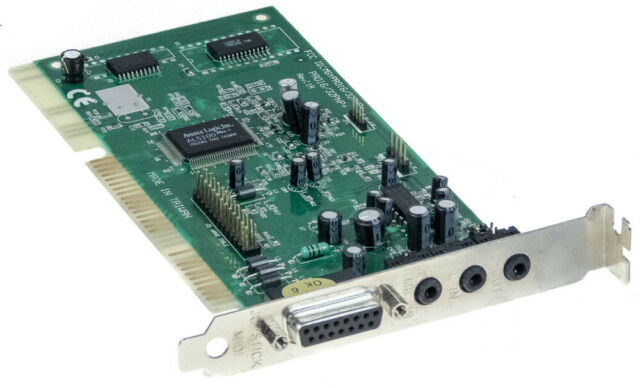  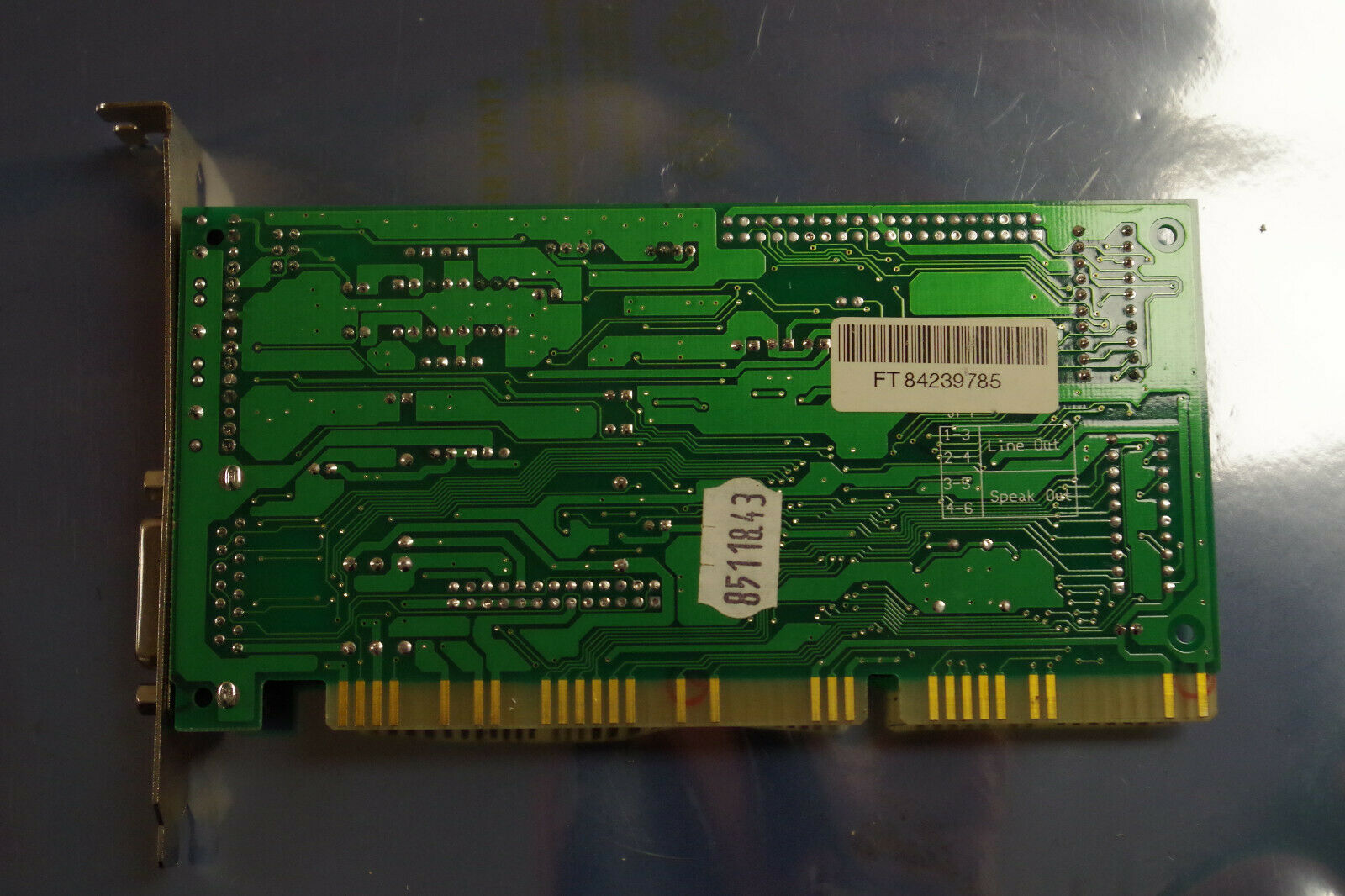 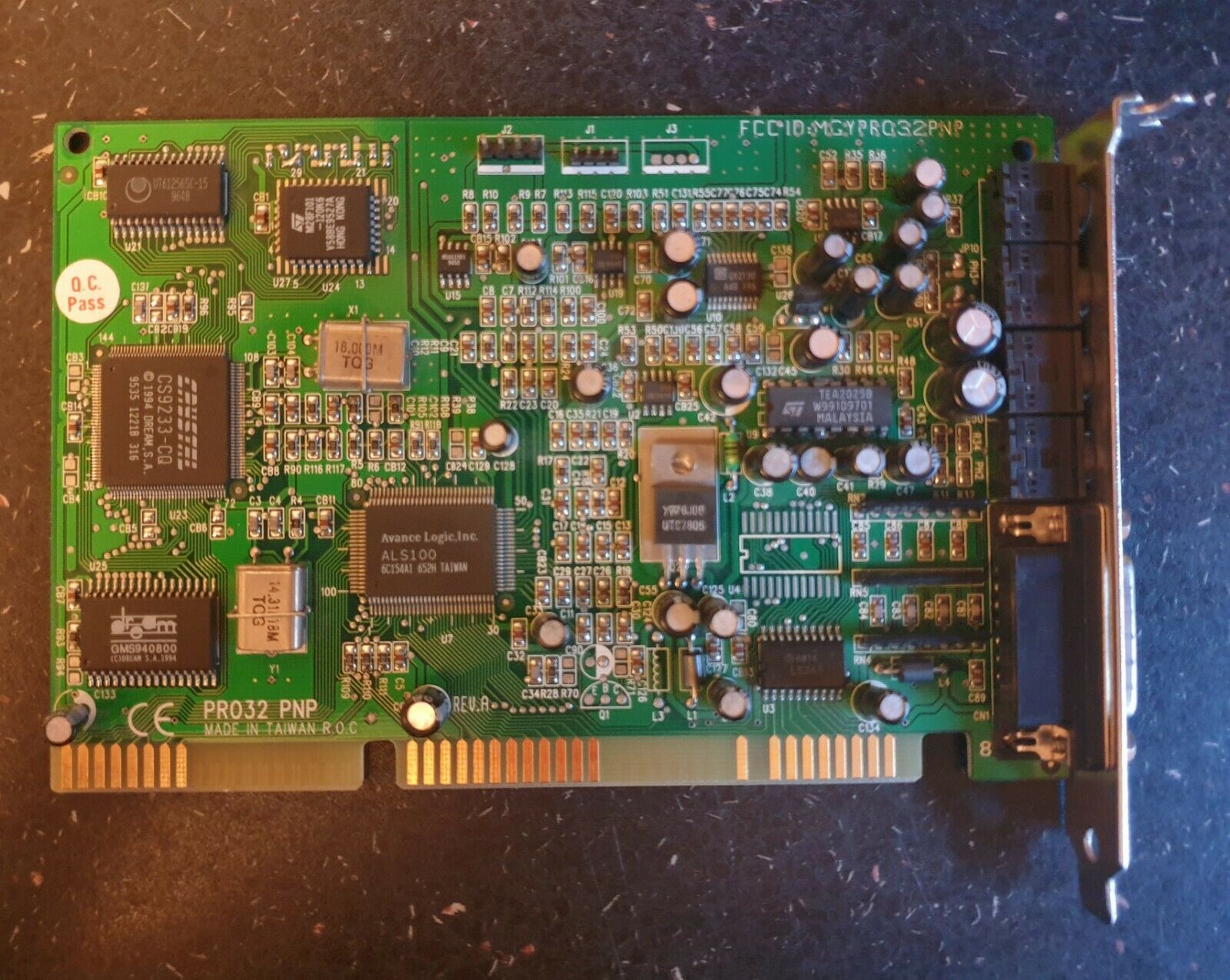 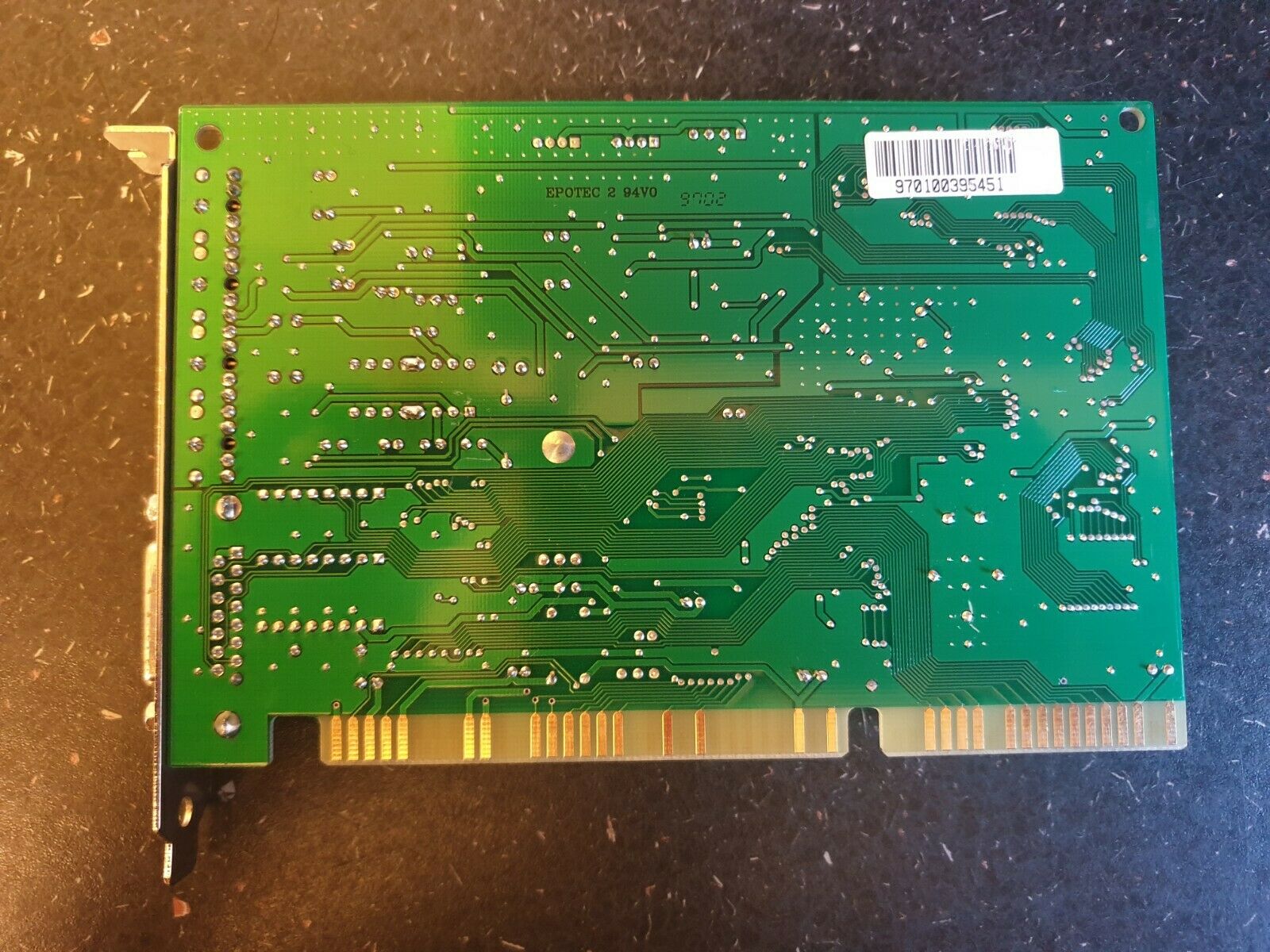 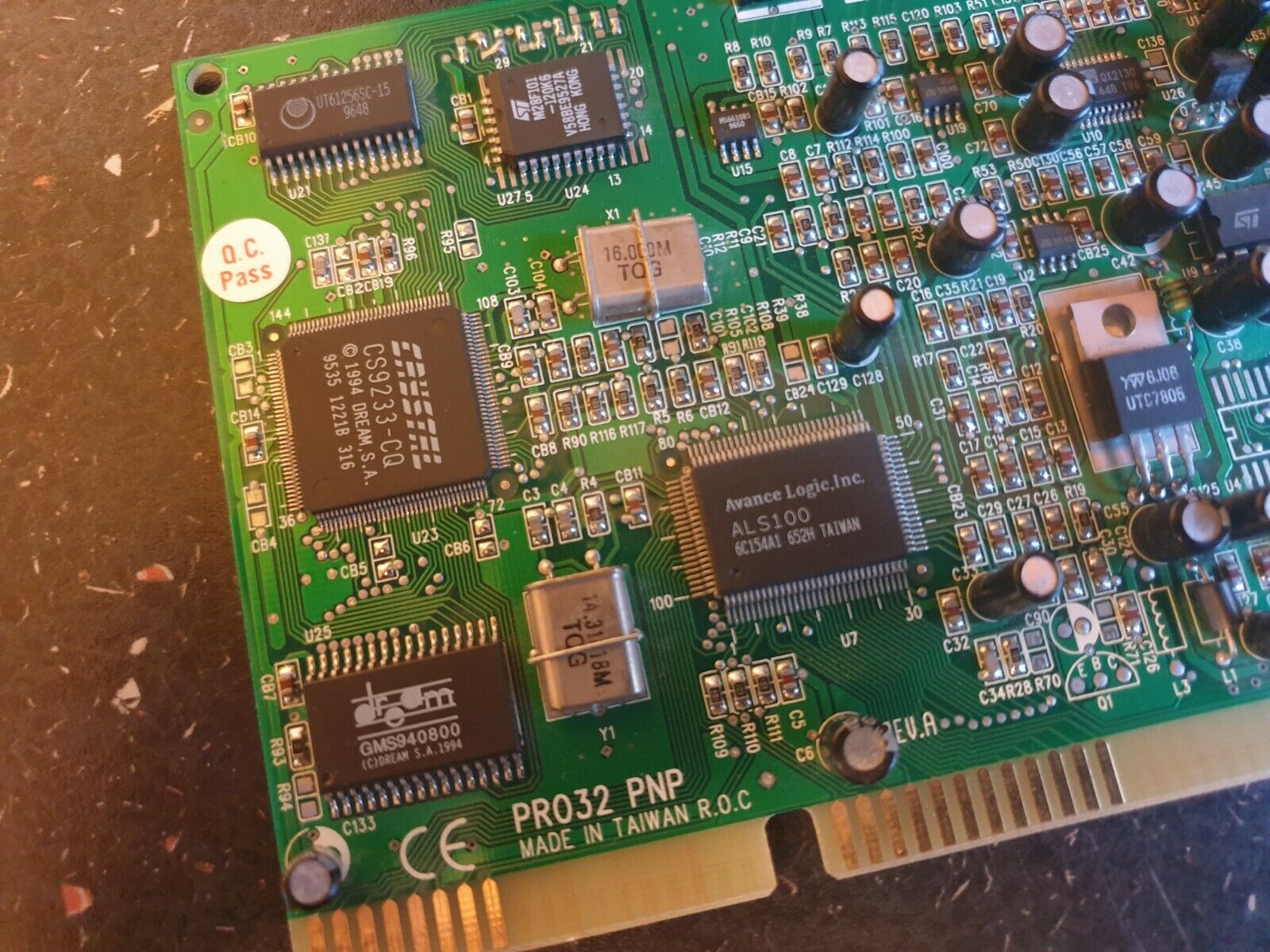 
|
ALS120         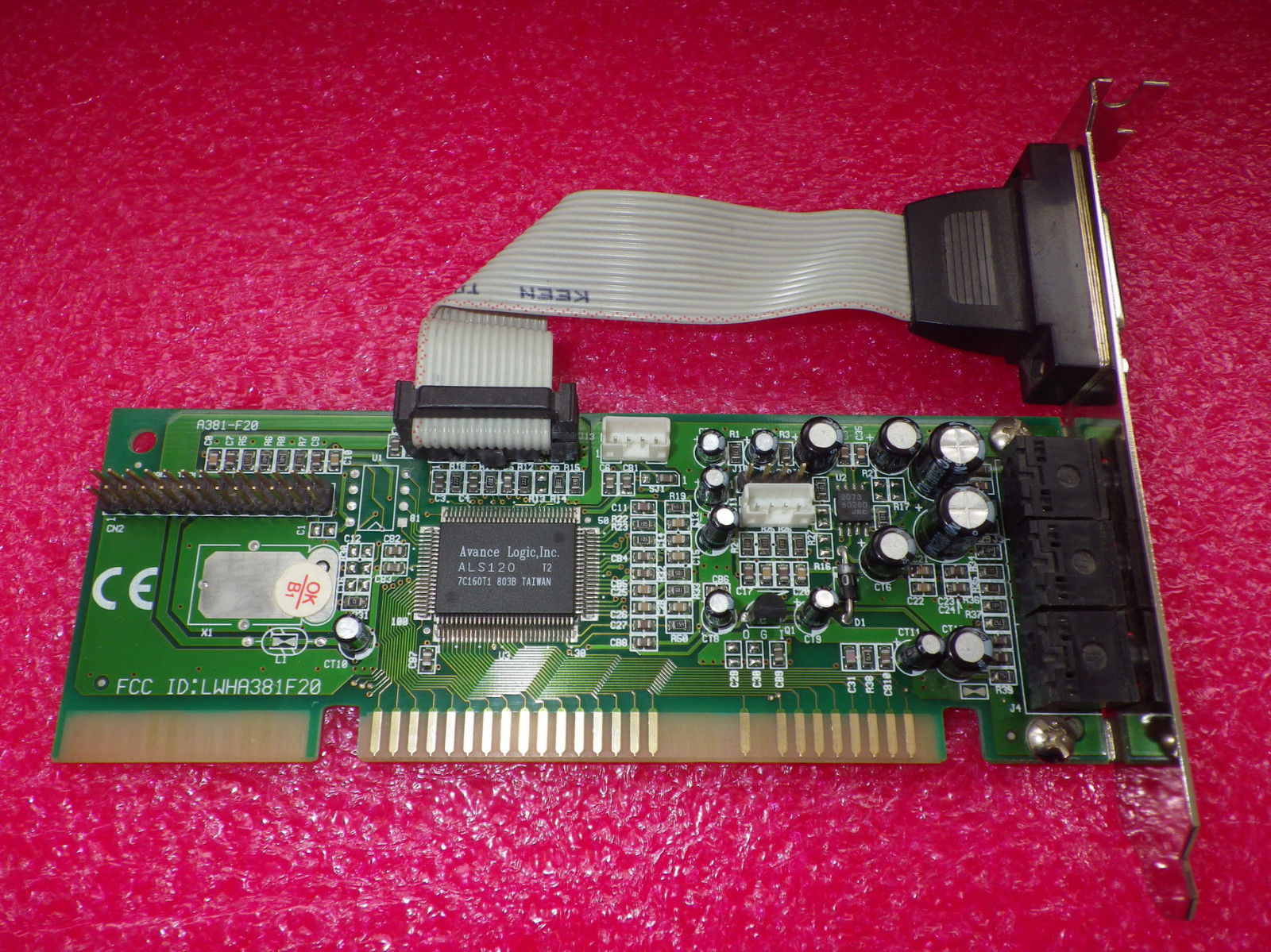
Introduced: 1997
FM Synthesizer: Embedded in ALS120 chip
Bus: 16-bit ISA
CD-ROM Interfaces: IDE (some variants)
Jacks: Line In, Line Out, Mic, Speaker
Wavetable Header: Yes
Plug & Play: Yes
FCC ID: LWHA381F20
The ALS120 is a Plug & Play card that provides compatibility with Sound Blaster, Sound Blaster Pro, Sound Blaster 16, and Windows Sound System. It differs from its predecessors by also having a
built-in 3D sound effects processor.
The game port can behave as an MPU-401 MIDI controller with FIFO (UART only).
This card was also sold as the Asonic Limbo 50+ and Asonic Asound Gold, both released in 1999.
There have been several recommendations to **avoid** these ALS120 cards completely, as they don't use a real or even unlicenced OPL3 chip, but a rather bad clone.
Manuals
ALS120 User Guide
ALS120 Design Manual
Drivers
DOS / Windows 3.1 / Windows 95 version ALS12.A1.30
Windows 98SE
NT 3.51 / 4.0
Windows 2000
OS/2 3.0
OS/2 4.0
More Images
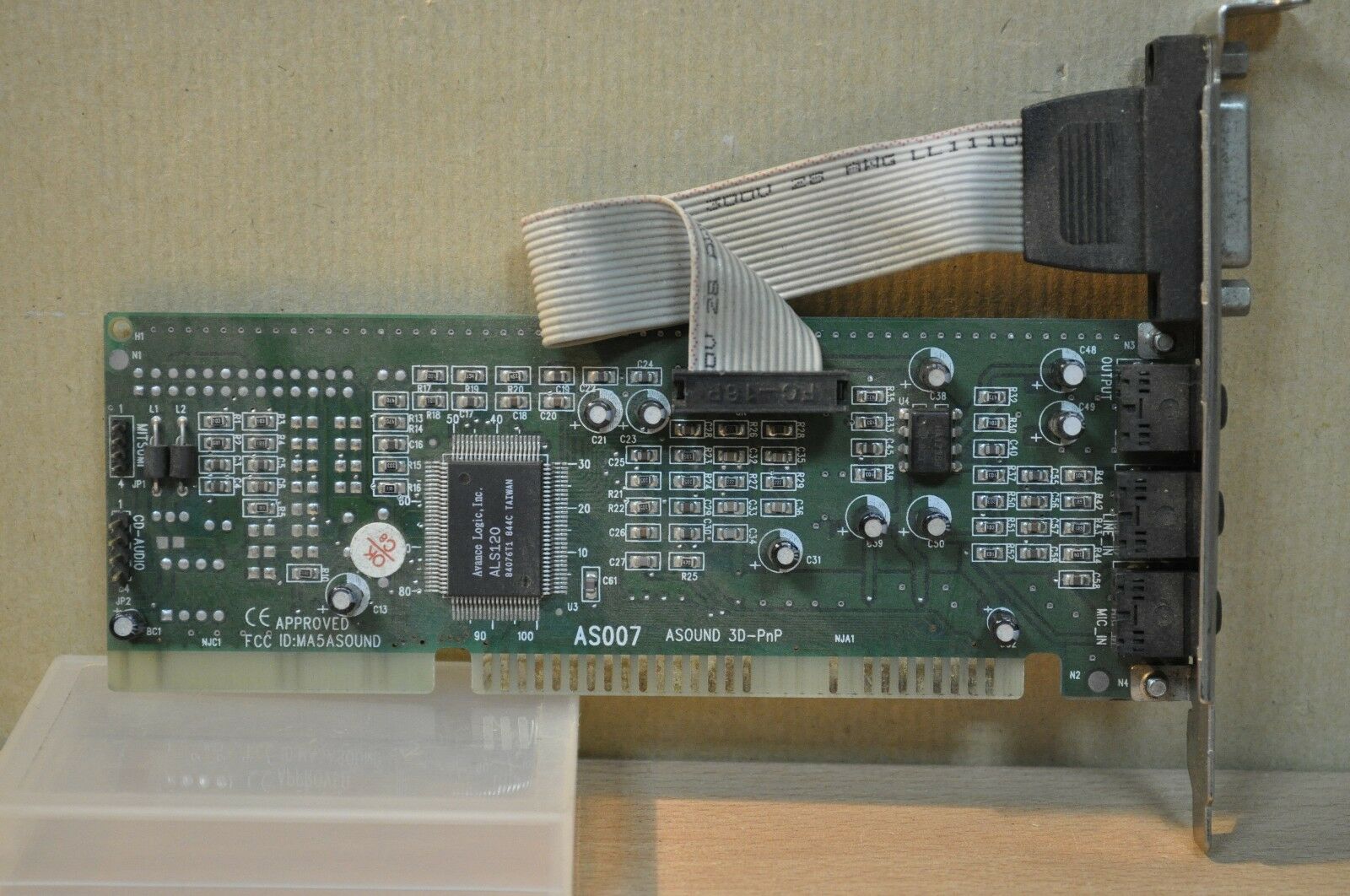 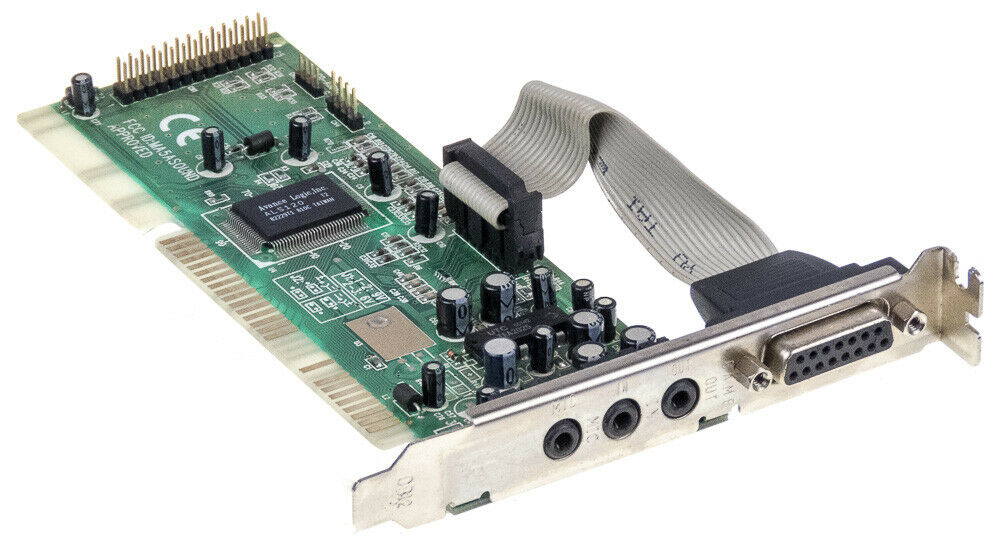
|
 ALS200 ALS200       
Introduced: 1997
FM Synthesizer: Embedded in ALS200 chip
Bus: 16-bit ISA
CD-ROM Interfaces: IDE
Jacks: Line Out, Mic, Speaker
Wavetable Header: Yes
Plug & Play: Yes
FCC ID: -
The ALS200 Plug & Play card provides compatibility with Sound Blaster, Sound Blaster Pro, Sound Blaster 16, and Windows Sound System.
The game port can behave as an MPU-401 MIDI controller with FIFO (UART only).
Manuals
ALS200 Design Manual
Schematics
DRIVERS
DOS / Windows 3.1 / 95
Windows 98
NT 3.51 / 4.0
OS/2 4.0
|
ALS300 (RL5305)        
Introduced: 1999
FM Synthesizer: Embedded
Bus: PCI
CD-ROM Interfaces: None
Jacks: Line Out, Mic, Speaker
Wavetable Header: No
Plug & Play: Yes
FCC ID: -
The ALS300 marks a move away from DOS compatibility, being a PCI card. Its ASIC chip, ALS300, emulates Sound Blaster Pro and Sound Blaster 16 and has a built-in FM synthesizer for OPL3 emulation.
The ALS300's primary target was Windows as it was Avance Logic's first card to comply with the AC'97 standard (Audio CODEC '97).
Manuals
ALS300 Technical Reference
DRIVERS
DOS / Windows 3.1 / 95
Windows 95 patch
NT 3.51 / 4.0
Windows 98 |
 ALS300Plus ALS300Plus
Introduced: 1999
Bus: PCI
DOS / Windows 3.1 / 95, Windows 95 patch, NT 3.51 / 4.0, Windows 2000 / XP |
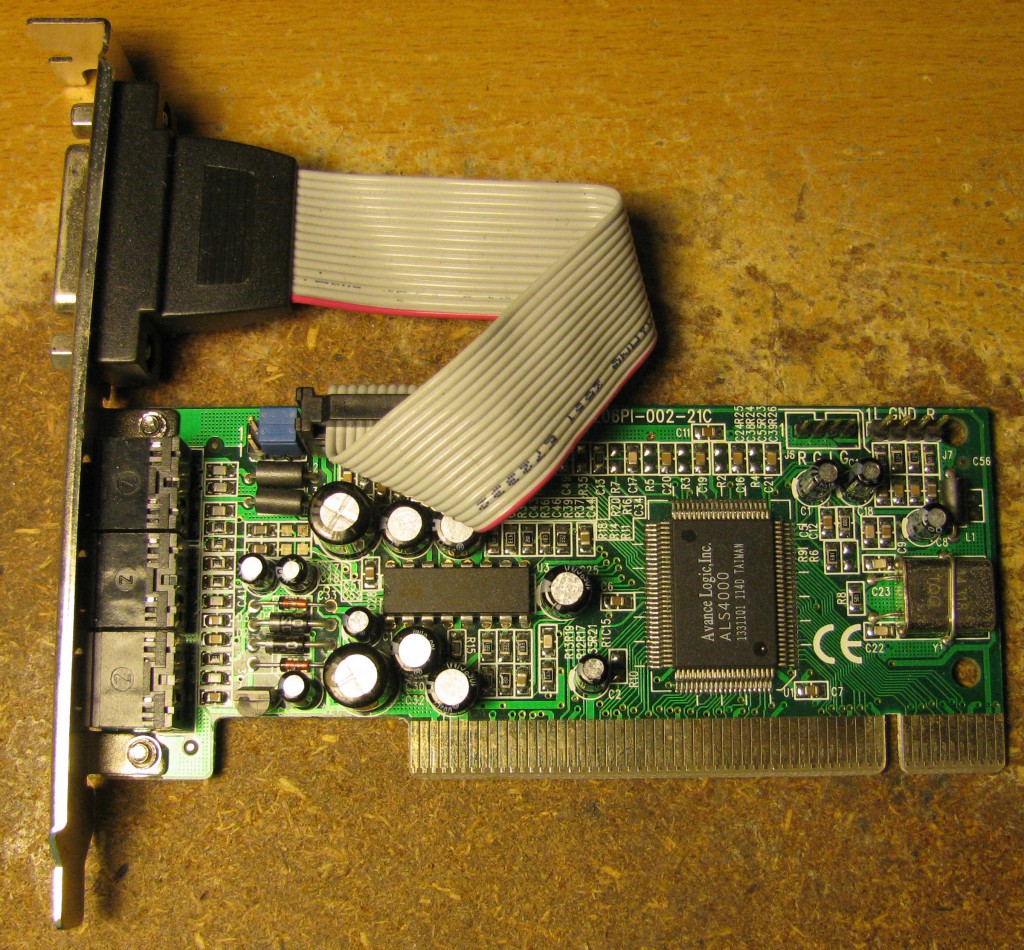 ALS4000 ALS4000       
Introduced: 1998
FM Synthesizer: Embedded
Bus: PCI
CD-ROM Interfaces: None
Jacks: Line Out, Mic, Speaker
Wavetable Header: No
Plug & Play: Yes
FCC ID: -
The ALS4000 is an integrated chip that includes an "ALSFM" synthesizer as well as an OPL4 wavetable synthesizer, and MIDI controller. This card is built around that single chip solution.
It is compatible with Ad Lib, Sound Blaster Pro, and Sound Blaster 16.
Its game/MIDI port supports the MPU-401 UART interface, and is fully compatible with Microsoft's Sidewinder joystick.
DOS Days contributor, Balázs Szabó, wrote this about his ALS4000 card: "ALSFM OPL3 vs. Yamaha OPL3: Both the ALSFM OPL3 and Yamaha OPL3 offer enjoyable sound quality in terms of OPL3 synthesis. Surprisingly, I find the ALS4000 to potentially outshine the Yamaha counterpart in certain aspects. Its unique tonal characteristics may appeal to enthusiasts seeking a distinct sonic experience.
Noise Level: Unfortunately, the card exhibits significant noise levels regardless of whether utilizing the 'Line Out' or 'Speaker Out' options. This noise detracts from the overall listening experience and may require additional measures for noise mitigation."
Manuals
ALS4000 Technical Reference
Drivers
DOS / Windows 3.1 / 95
NT 3.51 / 4.0
95/98/ME/2000/XP
Windows 98SE/2000 WDM Driver (without game port driver)
A separate DOS driver called ALS4KDOS was compiled back in 2002. Keep interrupt 5 or 7 (or 10, 11) free, and set its IRQ number in ALS4KDOS.CFG. Then just run als4kdos.exe from prompt in pure DOS, or run it from autoexec.bat.
This has been tested on the following chipsets: AMD 760, AMD 761 and VIA VT82C686B, Intel 430TX and 440BX, and SiS 630, SiS 730/735/745.
More images

.jpg) .jpg) .jpg) .jpg)
The images above are courtesy of
DOS Days contributor Balázs Szabó.
|
 Avance Logic / Realtek
Avance Logic / Realtek













.jpg)
















 ALS300Plus
ALS300Plus

.jpg)
.jpg)
.jpg)
.jpg)
.jpg)
.jpg)

